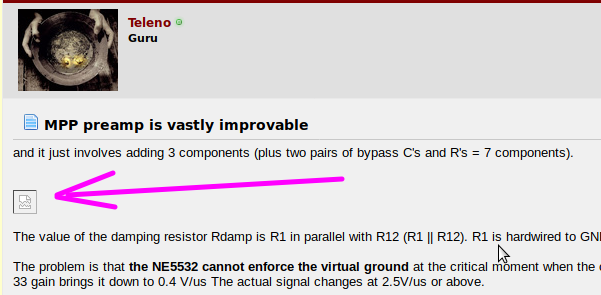and it just involves adding 3 components (plus two pairs of bypass C's and R's = 7 components).

The value of the damping resistor Rdamp is R1 in parallel with R12 (R1 || R12). R1 is hardwired to GND, but R12 is wired to the virtual ground at the (-) input of the NE5532 op amp.
The problem is that the NE5532 cannot enforce the virtual ground at the critical moment when the coil decay goes below the ON voltage of D5.. Even though the slew rate of the op amp is rated to 13V/us, the 33 gain brings it down to 0.4 V/us The actual signal changes at 2.5V/us or above.
While the op-amp tries to establish a virtual ground R12 is "floating" and not contributing to damping the coil's energy, causing ringing (oscillations). The virtual ground has to be set as soon as possible. In the MPP, the practical value of R1 || R12 that avoids oscillations is much lower than the ideal Rdamp (sqrt(L/4C)) because R12 is floating for too long. A lower Rdamp results in a much longer sampling delay than would be possible.
The solution is to add a low-gain stage at the preamp's input that can cope with the signal's slew rate. The low gain (typically 1 - 3) preserves more of the op-amp's slew rate. The NE5532 is designed for a gain > 3, otherwise it's not stable (it oscillates). It also should have a lower input noise than the NE5532 because it will add to the preamp chain. However, the extra noise is compensated for by the ability to sample much earlier, where the signal is stronger and the S/N ratio much higher. I would suggest an LM4562 (2.7nV noise, 55MHz, 20Vus slew rate) for this supplementary stage.
To ilustrate the difference between the MPP and a properly design preamp I've run two simulations showing the state of the virtual ground in both cases.
Simulated TX circuit:
- Coil inductance: 500uH
- Coil capacitance: 200pF
- Critical damping resistance: 790 Ohm.
R1 = 3K6 Ohm, in parrallel with R12 (1K Ohm) gives 782 Ohm, which is a bit below critical damping.
The behaviour of the MPP virtual ground is shown in red, the preamp with the additional stage in blue:

We see that the MPP oscillates at Rdamp, but the modified MPP does not. Also, the response of the preamp is much faster since the virtual ground is quickly established.
In order to avoid oscillation, the MPP requires R1 || R13 to be much lower than Rdamp, in this case about 470 Ohm (R1 = 900, R12 = 1000). The sampling delay increases by a whooping 8us, and, for the same TX current, the transient peak goes down from 500V to 330V.

The proposed preamplifier for the MPP will be in the next post.
The value of the damping resistor Rdamp is R1 in parallel with R12 (R1 || R12). R1 is hardwired to GND, but R12 is wired to the virtual ground at the (-) input of the NE5532 op amp.
The problem is that the NE5532 cannot enforce the virtual ground at the critical moment when the coil decay goes below the ON voltage of D5.. Even though the slew rate of the op amp is rated to 13V/us, the 33 gain brings it down to 0.4 V/us The actual signal changes at 2.5V/us or above.
While the op-amp tries to establish a virtual ground R12 is "floating" and not contributing to damping the coil's energy, causing ringing (oscillations). The virtual ground has to be set as soon as possible. In the MPP, the practical value of R1 || R12 that avoids oscillations is much lower than the ideal Rdamp (sqrt(L/4C)) because R12 is floating for too long. A lower Rdamp results in a much longer sampling delay than would be possible.
The solution is to add a low-gain stage at the preamp's input that can cope with the signal's slew rate. The low gain (typically 1 - 3) preserves more of the op-amp's slew rate. The NE5532 is designed for a gain > 3, otherwise it's not stable (it oscillates). It also should have a lower input noise than the NE5532 because it will add to the preamp chain. However, the extra noise is compensated for by the ability to sample much earlier, where the signal is stronger and the S/N ratio much higher. I would suggest an LM4562 (2.7nV noise, 55MHz, 20Vus slew rate) for this supplementary stage.
To ilustrate the difference between the MPP and a properly design preamp I've run two simulations showing the state of the virtual ground in both cases.
Simulated TX circuit:
- Coil inductance: 500uH
- Coil capacitance: 200pF
- Critical damping resistance: 790 Ohm.
R1 = 3K6 Ohm, in parrallel with R12 (1K Ohm) gives 782 Ohm, which is a bit below critical damping.
The behaviour of the MPP virtual ground is shown in red, the preamp with the additional stage in blue:
We see that the MPP oscillates at Rdamp, but the modified MPP does not. Also, the response of the preamp is much faster since the virtual ground is quickly established.
In order to avoid oscillation, the MPP requires R1 || R13 to be much lower than Rdamp, in this case about 470 Ohm (R1 = 900, R12 = 1000). The sampling delay increases by a whooping 8us, and, for the same TX current, the transient peak goes down from 500V to 330V.
The proposed preamplifier for the MPP will be in the next post.



Comment